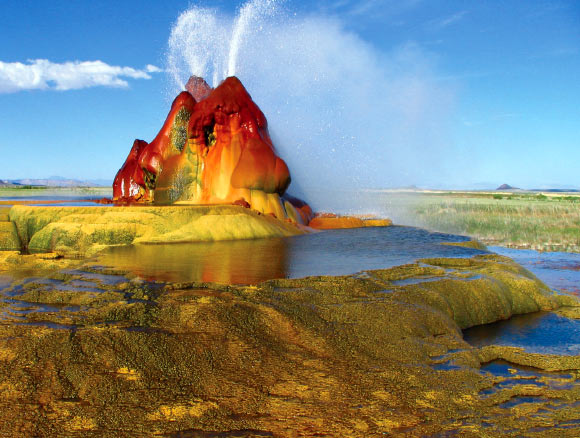Geysers erupt periodically because of loops or side-chambers in their underground plumbing, says a team of volcanologists from the United States and Japan.

Fly Geyser, a man-made small geothermal geyser located in Washoe County, Nevada. Image credit: Jeremy C. Munns.
Approximately 1,000 geysers exist around the world – half of them in Yellowstone – and all are located in active or formerly active volcanic areas.
Water from the surface trickles downward and gets heated by hot magma, eventually, perhaps decades later, rising back to the surface in the form of hot springs, mud pots and geysers.
Why geysers erupt periodically, some with a regularity you can set a clock by, has piqued the interest of many scientists.
“The key to geysers is an underground bend or loop that traps steam and then bubbles it out slowly to heat the water column above until it is just short of boiling,” said Prof Michael Manga of the University of California, Berkeley, who is a co-author of the paper published in the Journal of Volcanology and Geothermal Research.
In the paper, Prof Manga and his colleagues report on El Jefe, a geyser located at an elevation of 4,320 meters in the El Tatio geyser field in Chile, where water boils at 86 degrees Celsius instead of 100.
In 2012, they recorded internal and external data during 3,600 eruptions over six days. They compared these to above-ground measurements at Lone Star and other geysers in Yellowstone.
As a result, they identified four stages in the geyser cycle: “(i) recharge of water into the conduit after an eruption, driven by the pressure difference between water in the conduit and in a deeper reservoir; (ii) a pre-eruptive stage that follows the recharge and is dominated by addition of steam from below; (iii) the eruption, which occurs by rapid boiling of a large mass of water at the top of the water column, and decompression that propagates boiling conditions downward; and (iv) a relaxation stage during which pressure and temperature decrease until conditions preceding the recharge stage are restored.”
“Eruptions are triggered by the episodic addition of steam coming from depth, suggesting that the dynamics of the eruptions are dominated by geometrical and thermodynamic complexities in the conduit and reservoir,” the scientists wrote in the paper.
Prof Manga and his colleagues plan to continue Yellowstone and Chilean studies to gather more data to help explain the periods of geysers and better understand below-ground processes.
_____
Carolina Munoz-Saez et al. 2015. Dynamics within geyser conduits, and sensitivity to environmental perturbations: Insights from a periodic geyser in the El Tatio geyser field, Atacama Desert, Chile. Journal of Volcanology and Geothermal Research, vol. 292, pp. 41–55; doi: 10.1016/j.jvolgeores.2015.01.002







